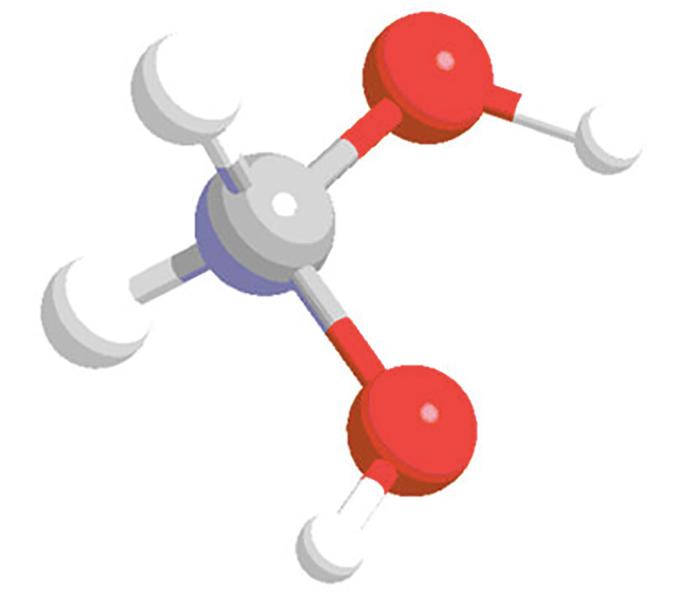
据美国夏威夷大学(University of Hawaii)2021年12月31日报道,该校马诺阿分校(University of Hawaii at Mānoa)的研究人员首次合成生产了以前难以捉摸的对有机、大气科学和天体化学(astrochemistry)界具有重要意义的亚甲基二醇分子(Elusive atmospheric molecule produced in a lab for the 1st time)。他们的发现和方法于2021年12月30 日已经在《美国国家科学院院刊》(Proceedings of the National Academy of Sciences)杂志网站发表——Cheng Zhu, N. Fabian Kleimeier, Andrew M. Turner, Santosh K. Singh, Ryan C. Fortenberry, Ralf I. Kaiser. Synthesis of methanediol [CH2(OH)2]: The simplest geminal diol. Proceedings of the National Academy of Sciences, January 4, 2022, 119(1): e2111938119. DOI: 10.1073/pnas.2111938119. https://www.pnas.org/content/119/1/e2111938119.参与此项研究的除了夏威夷大学马诺阿分校(University of Hawaii at Manoa)化学系和凯克天体化学实验室(W. M. Keck Laboratory in Astrochemistry, University of Hawaii at Manoa)的研究人员之外,还有来自美国密西西比大学化学与生物化学系(Department of Chemistry & Biochemistry, University of Mississippi)的研究人员。
甲二醇(Methanediol)也称为甲醛一水合物(formaldehyde monohydrate)或亚甲基二醇(methylene glycol),其化学式为CH2(OH)2,它是最简单的偕二醇(geminal diols)化合物,在单个碳原子上链接有两个羟基 (OH) 和两个氢原子(H)的分子。这些有机分子被认为是大气臭氧层气溶胶形成和反应的关键中间体。
由夏威夷大学马诺阿分校化学系教授拉尔夫·凯泽(Ralf Kaiser)、博士后研究人员朱诚(Cheng Zhu音译)、N. Fabian Kleimeier 和桑托什·辛格(Santosh Singh)以及W N凯克(W M Keck)天体化学实验室助理主任安德鲁·特纳(Andrew Turner)组成的研究团队,通过极低温冰的能量处理制备了甲二醇,并在 W M凯克天体化学实验室,通过利用可调谐真空光电离(光子与原子或分子的相互作用形成离子的过程)的高科技质谱工具来观察分析该分子。密西西比大学副教授瑞恩·福滕伯里(Ryan Fortenberry)进行的电子结构计算证实了该分子的气相稳定性,并证明了通过电子激发的氧原子与甲醇反应的途径。
研究人员说,这些发现提高了他们对偕二醇的基本化学和化学键合的认识,并表明它们在大气和星际环境中扮演着关键角色。天文学家现在可能能够使用射电望远镜来识别深空中难以捉摸的分子,例如甲二醇。
在寻找恒星形成区域之前,这种多才多艺的策略首先合成分子,如偕二醇可能最终使我们更接近于理解奇异有机分子的分子结构和化学键,根据教科书这些奇异分子是“不应该存在”的。但是上述论文的作者还计划研究甲三醇 [ CH(OH) 3 ] 和甲四醇 [ C(OH) 4 ]的稳定性和制备。
上述介绍,仅供参考。欲了解更多信息,敬请注意浏览原文或者相关报道。
Significance
Methanediol [CH2(OH)2] represents a pivotal atmospheric volatile organic compound and plays a fundamental role in aerosol growth. Although sought for decades, methanediol has never been identified due to the inherent dehydration tendency of two adjacent hydroxyl groups (OH) at the same carbon atom. Here, we prepare and identify methanediol via processing of low-temperature ices followed by sublimation into the gas phase. These findings open up a concept to synthesize and characterize unstable geminal diols—critical organic transients in Earth’s atmosphere. The excited state dynamics of oxygen may also lead to methanediol in methanol-rich interstellar ices in cold molecular clouds, followed by sublimation in star-forming regions and prospective detection of these reactive intermediates in the gas phase by radiotelescopes.
Abstract
Geminal diols—organic molecules carrying two hydroxyl groups at the same carbon atom—have been recognized as key reactive intermediates by the physical (organic) chemistry and atmospheric science communities as fundamental transients in the aerosol cycle and in the atmospheric ozonolysis reaction sequence. Anticipating short lifetimes and their tendency to fragment to water plus the aldehyde or ketone, free geminal diols represent one of the most elusive classes of organic reactive intermediates. Here, we afford an exceptional glance into the preparation of the previously elusive methanediol [CH2(OH)2] transient—the simplest geminal diol—via energetic processing of low-temperature methanol–oxygen ices. Methanediol was identified in the gas phase upon sublimation via isomer-selective photoionization reflectron time-of-flight mass spectrometry combined with isotopic substitution studies. Electronic structure calculations reveal that methanediol is formed via excited state dynamics through insertion of electronically excited atomic oxygen into a carbon–hydrogen bond of the methyl group of methanol followed by stabilization in the icy matrix. The first preparation and detection of methanediol demonstrates its gas-phase stability as supported by a significant barrier hindering unimolecular decomposition to formaldehyde and water. These findings advance our perception of the fundamental chemistry and chemical bonding of geminal diols and signify their role as an efficient sink of aldehydes and ketones in atmospheric environments eventually coupling the atmospheric chemistry of geminal diols and Criegee intermediates.
 科技公园
科技公园




